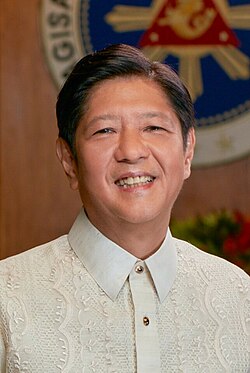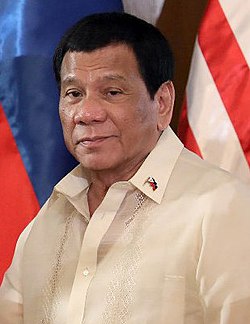President of the Philippines
The President of the Philippines (Filipino: [Pangulo ng Pilipinas] Error: {{Lang}}: text has italic markup (help), informally known as Presidente ng Pilipinas) is the head of state and head of government of the Philippines.
| President of the Philippines Pangulo ng Pilipinas | |
|---|---|
 | |
 | |
| Style |
|
| Member of | Cabinet National Security Council |
| Residence | Malacañan Palace |
| Seat | Manila, Philippines |
| Appointer | Direct popular vote |
| Term length | Six years; Not renewable |
| Constituting instrument | 1987 Constitution of the Philippines |
| Inaugural holder | Emilio Aguinaldo (official)a Manuel L. Quezon (de jure)b |
| Formation | January 23, 1899 (official)[1]a November 15, 1935 (de jure)[2]b |
| Deputy | Vice President of the Philippines |
| Salary | ₱399,739 per month / ₱4,796,868 per year |
| Website | www |
The President leads the executive branch of the Philippine government and is the commander-in-chief of the Armed Forces of the Philippines. The President is directly elected by the people, and is one of only two nationally elected executive officials, the other being the Vice President of the Philippines.
However, four vice presidents have assumed the presidency without having been elected to the office, such as by the death or resignation of an incumbent president.[note 1]
Filipinos refer to their President as Pangulo or Presidente. The President serves a single, fixed, six-year term without possibility of re-election. On June 30, 2022, Bongbong Marcos was sworn in as the 17th and current president.
Eligibility
Article 7, Section 2 of the Constitution reads that in order to be eligible for President the person must:
- Be a natural-born citizen of the Philippines
- A registered voter
- Able to read and write
- At least forty years of age on the day of the election
- A resident of the Philippines for at least ten years immediately before the election[3]
List
Living former presidents
As of December 2025, there are three living former Presidents:
The most recent president to die was Fidel V. Ramos (served 1992–1998), on July 31, 2022, at the age of 94.
President Of The Philippines Media
125th anniversary celebration of the First Philippine Republic was commemorated at Barasoain Church in Malolos, Bulacan.
Home provinces (blue and purple) of the presidents.
Carlos P. Garcia is sworn in as the eighth president of the Philippines after winning the election of 1957
Bongbong Marcos during his inauguration
President Bongbong Marcos during his first State of the Nation Address on July 25, 2022.
Gloria Macapagal Arroyo delivering her seventh State of the Nation Address at the Batasang Pambansa
Sergio Osmeña was the first vice president to succeed to the presidency upon the death of a chief executive, who was Manuel L. Quezon, in 1944.
An Aérospatiale SA-330 Puma carrying President Corazon C. Aquino at Subic Bay Naval Base.
Notes
- ↑ The four vice presidents who succeeded to the presidency upon their predecessor's death or resignation and finished-out that unexpired term are: Sergio Osmeña (1944); Elpidio Quirino (1948); Carlos P. Garcia (1957); Gloria Macapagal Arroyo (2001).
References
- ↑ "Emilio Aguinaldo". Official Gazette of the Philippine Government. March 22, 2011.[dead link]
- ↑ Guevara, Sulpico, ed. (2005). The laws of the first Philippine Republic (the laws of Malolos) 1898–1899. Ann Arbor, Michigan: University of Michigan Library (published 1972). Retrieved January 10, 2011.
- ↑ 1987 Constitution of the Philippines, art. 7, sec. 2
Other websites
- Office of the President of the Philippines Archived 2012-07-05 at the Wayback Machine
- The Presidential Museum and Library Archived 2016-05-27 at the Wayback Machine
- 1987 Constitution of the Philippines
- 'We Say Mabuhay' – The Anthem of the President of the Philippines
- 'March of the President of the Philippines' (unofficial title) – song played when the President is given military honors by the Armed Forces of the Philippines












